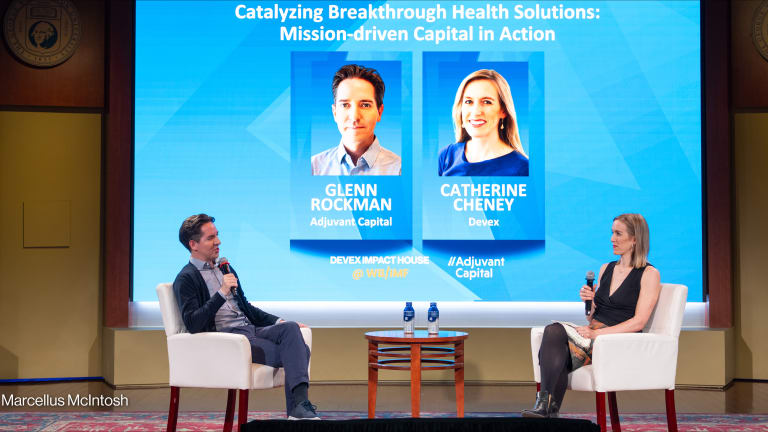
Universal health coverage promises to give all people greater access to a package of quality essential health services without fear of financial hardship. Turning this vision into reality often poses a significant challenge, with many countries — at all stages of economic development — facing a funding gap to achieve UHC. Global health stakeholders, including governments, foundations, and even the business community, are eager to mobilize greater, more diverse, and more sustainable financing to improve health around the world, and many are looking to “innovative financing” as one solution.
“Innovative financing”
A broad term used to refer to many things, including:
• Traditional financing mechanisms, such as debt and equity financing that are considered “innovative” because they have not been widely used as part of global health funding.
• New, nontraditional partnerships that blend public and private sources of funding, along with distinctive expertise and perspectives that governments and the private sector bring.
• A combination of investment instruments with different expectations for returns, in conjunction with more traditional development assistance, such as grants and concessional loans.
As an example of the excitement around innovative financing, last year the U.S. passed legislation to create a new federal agency — the U.S. International Development Finance Corporation — charged with deploying a more flexible array of financial instruments to encourage private capital and supplement public funding for international development. DFC will combine the capabilities of the Overseas Private Investment Corporation and USAID’s Development Credit Authority, helping to expand the toolbox of financing mechanisms to include debt, equity, and loan guarantees for health and development.
Outside of government, many leading philanthropic foundations — including the Rockefeller Foundation and the Bill & Melinda Gates Foundation — have established portfolios exclusively focused on innovative financing that includes seed funding, equity financing, or debt financing with low interest rates. The Global Health Investment Fund, launched in 2013 by JPMorgan Chase & Co. and the Gates Foundation to advance the development of drugs, vaccines, diagnostics, and other interventions against infectious diseases affecting vulnerable populations, is one of many examples of how philanthropy is pushing the field in the social investment space.
Meanwhile, in the private sector, there is growing interest in “impact investing” — one kind of innovative financing — where investors seek social or environmental returns along with financial ones. For example, firms such as LeapFrog Investments and Blue like an Orange are helping direct private equity into investments that will contribute to better health care.
Why financing is different in the health sector
To date, innovative finance has been underutilized in health compared to sectors such as energy and the environment. One reason for this may be that changes in health take time to realize. Attracting private capital to the health sector requires demonstrating that the flow of capital — no matter how capital is delivered — will enable improved health outcomes. However, progress in health is slow, making it more difficult to attract funding from parties that need to see results within a relatively narrow window of time — such as those one might expect from the construction of energy efficient buildings.
Another reason may be that many forms of innovative financing include expectations for a financial return — particularly mechanisms such as impact investing, requiring recipients to have a viable business model. The sourcing and due diligence of such recipients, particularly in health care, is an important consideration that requires both technical and local knowledge, and a network to help surface the opportunities. In many markets, this is no easy task and can stifle the use of innovative financing. However, the health care industry is rapidly evolving in emerging markets. With the rise of innovative social business models for health, more opportunities for innovative financing will likely arise.
Food for thought
Q&A: Peter Sands on what it takes to create effective health systems
"The pathway to UHC is not something you reach by investing in something called UHC," says the executive director of the Global Fund, Peter Sands.
Efforts to use innovative financing for health have had mixed success. A number of publications — including the Lancet and BMJ — highlight challenges such as defining and demonstrating health impact that matters to patients and striking an attractive risk-versus-return ratio to attract private sector capital.
Many lessons can be learned from innovative financing programs. For example, Rabin Martin’s work supporting the Utkrisht impact bond and Financing for MOMs offers some important takeaways to keep in mind:
1. Innovative financing may be the solution you’re looking for — or it may not
Innovative financing is not a plug-and-play solution. Parties interested in utilizing an innovative financing mechanism should think through three key questions:
1. Is the barrier to achieving a specific goal related to financing, or something else?
2. What kinds of stakeholders would want to come together to solve this challenge?
3. What social and financial returns would stakeholders need to see to consider participating?
2. Defining social return on investment is just as important as defining financial returns
Evaluating — and then communicating — about how innovative financing contributes to national health goals requires thoughtful monitoring of social returns in addition to financial returns. Whether funding product introduction or health care delivery, it’s important to think carefully about what indicators to track. For example, assessing the use of innovative financing to spur improvements to a supply chain might go beyond measuring the availability of products and look at actual patient uptake or satisfaction.
3. New, nontraditional partnerships are part of what makes innovative financing innovative
Successfully developing and deploying innovative financing mechanisms for health requires a unique blend of knowledge and skills: familiarity with the health issue that is being addressed and the market where investments are planned, as well as how to conduct risk assessments and structure deals. Aggregating this expertise may be difficult, but if done right, benefits can extend beyond the life of the “deal.” These include establishing a long-term presence in a country or region, shaping national or regional policy dialogues, enhanced reputation, deeper understanding of markets, identification of new customer populations, improved patient and provider practices, and most importantly — sustained population health improvements.
Looking ahead
As global health stakeholders continue to explore whether and how to use innovative financing to strengthen health systems and improve health outcomes, it is important to be realistic about what such financing can achieve.
To move the needle on UHC, the global health community will need to work closely with national governments to address other areas of need that go beyond financing — such as human resources for health, improved health system infrastructure, access to medicines and medical technologies such as devices and diagnostics, enhanced insurance mechanisms, health information systems, and patient and community engagement. The development and mobilization of innovative financing mechanisms is just one tool in a larger toolbox to help ensure that all people have access to quality health care.
For a closer look at the innovative solutions designed to push for progress on universal health coverage around the globe, visit the Healthy Access series here.









